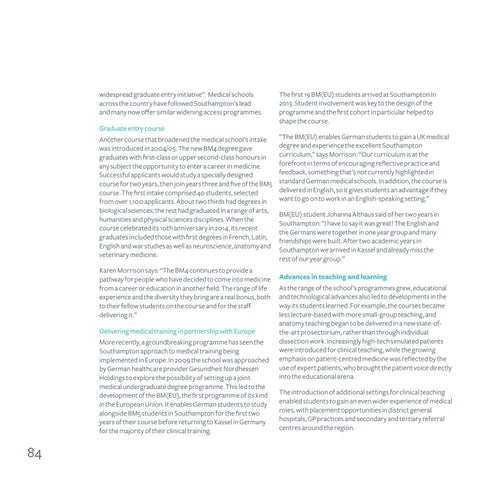widespread graduate entry initiative”. Medical schools across the country have followed Southampton’s lead and many now offer similar widening access programmes. Graduate entry course Another course that broadened the medical school’s intake was introduced in 2004/05. The new BM4 degree gave graduates with first-class or upper second-class honours in any subject the opportunity to enter a career in medicine. Successful applicants would study a specially designed course for two years, then join years three and five of the BM5 course. The first intake comprised 40 students, selected from over 1,100 applicants. About two thirds had degrees in biological sciences; the rest had graduated in a range of arts, humanities and physical sciences disciplines. When the course celebrated its 10th anniversary in 2014, its recent graduates included those with first degrees in French, Latin, English and war studies as well as neuroscience, anatomy and veterinary medicine. Karen Morrison says: “The BM4 continues to provide a pathway for people who have decided to come into medicine from a career or education in another field. The range of life experience and the diversity they bring are a real bonus, both to their fellow students on the course and for the staff delivering it.” Delivering medical training in partnership with Europe More recently, a groundbreaking programme has seen the Southampton approach to medical training being implemented in Europe. In 2009 the school was approached by German healthcare provider Gesundheit Nordhessen Holdings to explore the possibility of setting up a joint medical undergraduate degree programme. This led to the development of the BM(EU), the first programme of its kind in the European Union. It enables German students to study alongside BM5 students in Southampton for the first two years of their course before returning to Kassel in Germany for the majority of their clinical training.
84
The first 19 BM(EU) students arrived at Southampton in 2013. Student involvement was key to the design of the programme and the first cohort in particular helped to shape the course. “The BM(EU) enables German students to gain a UK medical degree and experience the excellent Southampton curriculum,” says Morrison. “Our curriculum is at the forefront in terms of encouraging reflective practice and feedback, something that’s not currently highlighted in standard German medical schools. In addition, the course is delivered in English, so it gives students an advantage if they want to go on to work in an English-speaking setting.” BM(EU) student Johanna Althaus said of her two years in Southampton: “I have to say it was great! The English and the Germans were together in one year group and many friendships were built. After two academic years in Southampton we arrived in Kassel and already miss the rest of our year group.” Advances in teaching and learning As the range of the school’s programmes grew, educational and technological advances also led to developments in the way its students learned. For example, the courses became less lecture-based with more small-group teaching, and anatomy teaching began to be delivered in a new state-ofthe-art prosectorium, rather than through individual dissection work. Increasingly high-tech simulated patients were introduced for clinical teaching, while the growing emphasis on patient-centred medicine was reflected by the use of expert patients, who brought the patient voice directly into the educational arena. The introduction of additional settings for clinical teaching enabled students to gain an even wider experience of medical roles, with placement opportunities in district general hospitals, GP practices and secondary and tertiary referral centres around the region.
